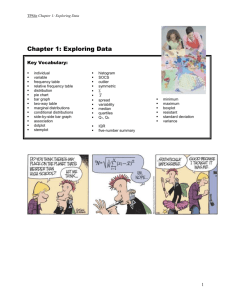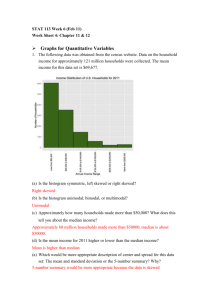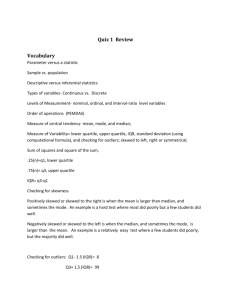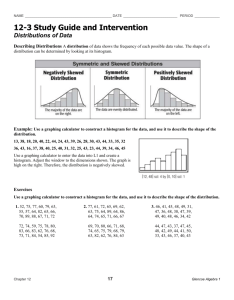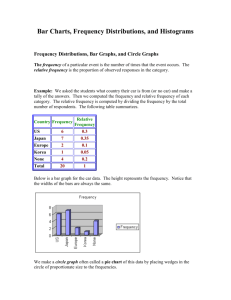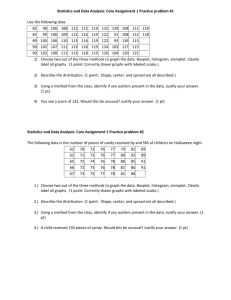AP Stats Chapter 1 Guided Reading Notes 2015
advertisement
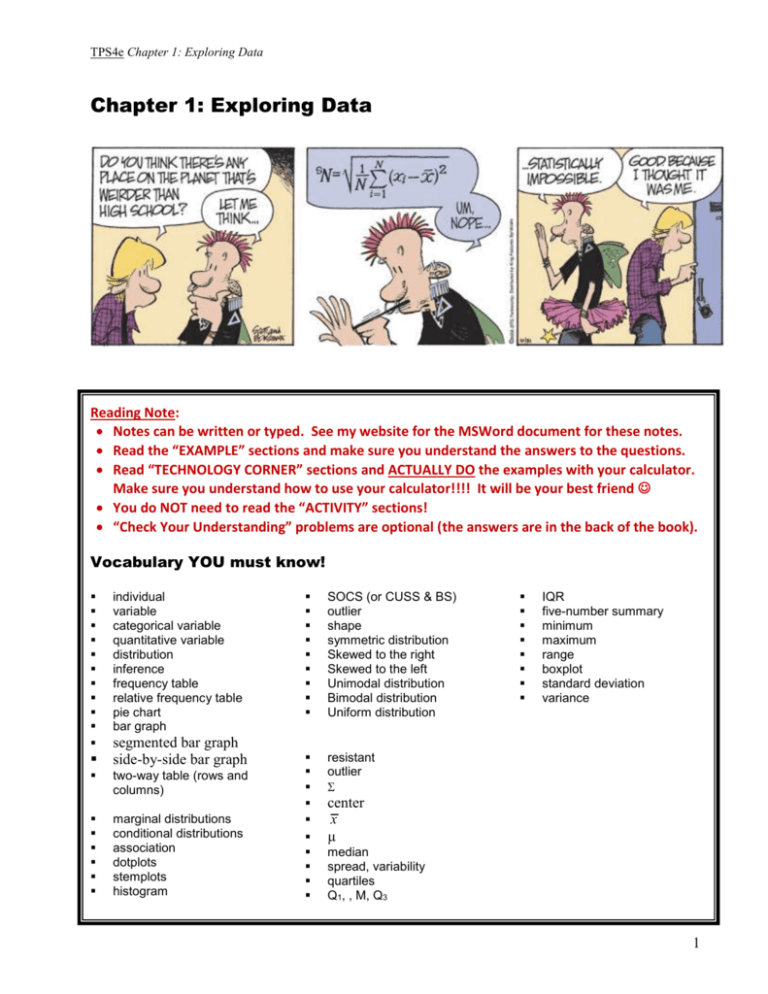
TPS4e Chapter 1: Exploring Data Chapter 1: Exploring Data Reading Note: Notes can be written or typed. See my website for the MSWord document for these notes. Read the “EXAMPLE” sections and make sure you understand the answers to the questions. Read “TECHNOLOGY CORNER” sections and ACTUALLY DO the examples with your calculator. Make sure you understand how to use your calculator!!!! It will be your best friend You do NOT need to read the “ACTIVITY” sections! “Check Your Understanding” problems are optional (the answers are in the back of the book). Vocabulary YOU must know! individual variable categorical variable quantitative variable distribution inference frequency table relative frequency table pie chart bar graph segmented bar graph side-by-side bar graph two-way table (rows and columns) marginal distributions conditional distributions association dotplots stemplots histogram SOCS (or CUSS & BS) outlier shape symmetric distribution Skewed to the right Skewed to the left Unimodal distribution Bimodal distribution Uniform distribution IQR five-number summary minimum maximum range boxplot standard deviation variance resistant outlier center x µ median spread, variability quartiles Q1, , M, Q3 1 TPS4e Chapter 1: Exploring Data Introduction Data Analysis: Making Sense of Data 1. Individuals are… 2. A variable (IT IS NOT X) is … 3. Explain the difference between a categorical variable and a quantitative variable. Give examples of categorical variables: Give examples of quantitative variables: 4. Define distribution: 5. Explain what inference is: In your own words, explain the example discussed on page 5: 2 TPS4e Chapter 1: Exploring Data 1.1 Analyzing Categorical Data 1. What is the difference between a data table, frequency table, and relative frequency table? 2. What type of data are pie charts and bar graphs used for? 3. Bar graphs represent each_______________________ as a bar and the bar heights give the category _____________________ or ____________________. 4. What is a two-way table (tip: sketch an example and discuss rows and columns)? 5. Define marginal distribution: 6. Define conditional distribution: Describe how you decide which conditional distribution to compare (pg17, think about it: explanatory vs. response). 3 TPS4e Chapter 1: Exploring Data 7. Use the following two-way table, a) To explain the difference between a marginal distribution and a conditional distribution. b) To give an example demonstrating how to calculate a marginal distribution: c) To give an example demonstrating how to calculate a conditional distribution: 8. What is the purpose of using a segmented bar graph and side-by-side bar graph? 9. Explain the difference between a segmented bar graph and side-by-side bar graph (an easy way to do this is to sketch graphs of each and show the differences). 10. Explain what it meant by an association between two variables; Give an example. 11. SKIP SIMPSON’S PARODOX. 4 TPS4e Chapter 1: Exploring Data 1.2 Analyzing Categorical Data 1. Here is a sketch of a dotplot. What is the advantage of using this type of graph (discuss size of the data set and what the graph shows)? What does each Dot represent? What is missing from graph? 2. [VERY IMPORTANT CONCEPT!!] When examining a distribution, you must describe the overall pattern with these 4 components. AND if you compare 2or more distributions, you must write a sentence for each of the following 4 components. Each sentence iscusses a component and compared the distributuions. S___________ O__________ C________ S_________ I call this CUSS and BS. You can use either mnemonic. Center, Unusual, Shape, Spread and Be Specific, Make sure you understand how to compare distributions in context. 3. Describe Shape a) Describe and illustrate the following distributions: Symmetric (do NOT use the word Skewed to the right NORMAL here!) (or positively skewed) Skewed to the left (or negatively skewed) 5 TPS4e Chapter 1: Exploring Data Describe Shape (continued) \ b) Describe and illustrate the following distributions: Unimodal (do NOT use NORMAL!) Bimodal (Don’t worry about little bumps) Uniform 4. What is the advantage of using a stemplot (discuss size of the data set and what the graph shows)? Give an example of a KEY, which is required in stemplot graph: a) When is it beneficial to split the stems on a stemplot? b) When is it best to use a back-to-back stemplot? 5. When is a histogram a better choice of a graph than a dotplot or a stemplot? 6. Are bar graphs and histogram the same? NO! IMPORTANT Make sure you understand the differences!!! Bar graphs display "categorical data" and the bars are NOT connected. Histograms display "continuous numerical data", that is data that represents measured quantity, and the bars are connected to show the shape of the distribution 7. List the three steps involved in making a histogram. 8. Why is it advantageous to use a relative frequency histogram instead of a frequency histogram? 9. Do Technology Corner (page 38) problem. Make sure you understand how to (1) put data in lists, (2) change window settings to easily sketch your graph, and (3) graph histograms. 6 TPS4e Chapter 1: Exploring Data 1.3 Analyzing Categorical Data Describe Center 1. What is the meaning of (sigma)? ̅ (Xbar): 2. For mean, 𝒙 give the formula and explain how to use it explain where to find the mean on the calculator ̅ and (mu). 3. Explain the difference between 𝒙 4. Define resistant measure: 5. Explain why the mean is not a resistant measure of center. 6. What is the median (M) of a distribution Explain how to calculate median by hand , when there is an odd number of data values Explain how to calculate median by hand , when there is an even number of data values Explain where to find the median on the calculator 7. Explain why the median is a resistant measure of center? 7 TPS4e Chapter 1: Exploring Data Describe Center (continued) 8. How does the shape of the distribution affect the mean and median? Shape is symmetric Shape is skewed right Shape is skewed left Describe Spread and Outliers 9. What is the range? IMPORTANT: range is a single number! 10. Is the range a resistant measure of spread? Explain. 11. Quartiles: How do you find the first quartile Q1 by hand? How do you find the third quartile Q3 by hand? Explain where to find the quartiles on the calculator \ 8 TPS4e Chapter 1: Exploring Data Describe Spread and Outliers (continued) 12. What is the Interquartile Range (IQR)? IMPORTANT: it is a single number! 13. Is the IQR a resistant measure of spread? Explain. 14. How is the IQR used to identify outliers? Large outliers Small outliers 15. What is the five-number summary of a distribution? 16. Explain how to use the five-number summary to make a boxplot. How do you identify outliers? 17. Do Technology Corner (page 61) problem. Data for NC is on page 56. Data for NY is on page 57. Make sure you understand how to put (1) data in lists, (2) change window settings, (3) graph box plots with outliers identified; and (4) graph side-by side box plots. 9 TPS4e Chapter 1: Exploring Data Describe Spread and Outliers (continued) . 18. Standard deviation (s or sx): What does the standard deviation (s or sx) measure? give the formula and explain how to use it explain where to find the standard deviation on the calculator 19. Variance (sx 2or s2) What does the variance (sx 2or s2) measure? give the formula for variance explain where to find the variance on the calculator Why do we prefer to use standard deviation and NOT variance? 20. What are the 4 properties of the standard deviation explained on page 64? 21. Do Technology Corner (page 65) problem to find summary statistics. Data for NC is on page 56. Data for NY is on page 57. Make sure you understand how to put (1) data in lists, (2) find onevariable statistics, and (3) read computer output given one-variable statistics. 22. How should one go about choosing measures of center and spread? 10
